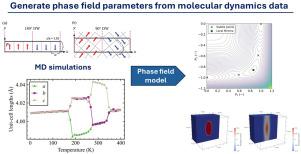Parameterization of a phase field model for ferroelectrics from molecular dynamics data
IF 8.3
1区 材料科学
Q1 MATERIALS SCIENCE, MULTIDISCIPLINARY
引用次数: 0
Abstract
In this work, molecular dynamics (MD) simulations of ferroelectric BaTiO are used to generate parameters for a phase-field (PF) model. The MD simulations provide important input parameters, such as elastic and piezoelectric properties, as well as domain wall (DW) widths and velocities. A parameterization technique is proposed to incorporate the MD results into the PF simulations, allowing for the generation of relevant parameters. Anisotropic interface energy coefficients are used to match the widths of both the 180° and 90° DWs in the PF simulations to the MD data. The velocities of the DWs are calculated and compared to the results obtained from MD simulations, demonstrating excellent agreement. Furthermore, we investigate the disparity between coercive fields obtained from PF simulations and MD simulations. Initially, our PF simulations yield coercive fields approximately twice as high as those observed in MD simulations. To address this discrepancy, we introduce a nucleus into the PF simulation system. The parameters of this nucleus are derived from a statistical analysis of coercive field data from MD simulations. By incorporating the nucleus model, we achieve a coercive field in PF simulations that closely aligns with the MD results. Validation of the parameterized PF model using MD data obtained with different initial conditions and thermodynamic constraints shows good agreement, further confirming the model’s accuracy.


根据分子动力学数据确定铁电体相场模型的参数
本研究利用铁电体 BaTiO33 的分子动力学(MD)模拟来生成相场(PF)模型的参数。MD 模拟提供了重要的输入参数,如弹性和压电特性以及畴壁(DW)宽度和速度。我们提出了一种参数化技术,可将 MD 结果纳入 PF 模拟,从而生成相关参数。各向异性界面能量系数用于将 PF 模拟中 180° 和 90° DW 的宽度与 MD 数据相匹配。我们计算了 DW 的速度,并将其与 MD 模拟的结果进行了比较,结果显示两者非常吻合。此外,我们还研究了 PF 模拟和 MD 模拟得到的胁迫场之间的差异。最初,我们的 PF 模拟得到的矫顽力场大约是 MD 模拟观察到的矫顽力场的两倍。为了解决这一差异,我们在 PF 模拟系统中引入了一个原子核。这个核的参数是通过对 MD 模拟中的胁迫场数据进行统计分析得出的。通过加入核模型,我们在 PF 模拟中得到了与 MD 结果非常接近的胁迫场。利用在不同初始条件和热力学约束条件下获得的 MD 数据对参数化 PF 模型进行了验证,结果显示两者吻合良好,进一步证实了该模型的准确性。
本文章由计算机程序翻译,如有差异,请以英文原文为准。
求助全文
约1分钟内获得全文
求助全文
来源期刊

Acta Materialia
工程技术-材料科学:综合
CiteScore
16.10
自引率
8.50%
发文量
801
审稿时长
53 days
期刊介绍:
Acta Materialia serves as a platform for publishing full-length, original papers and commissioned overviews that contribute to a profound understanding of the correlation between the processing, structure, and properties of inorganic materials. The journal seeks papers with high impact potential or those that significantly propel the field forward. The scope includes the atomic and molecular arrangements, chemical and electronic structures, and microstructure of materials, focusing on their mechanical or functional behavior across all length scales, including nanostructures.
 求助内容:
求助内容: 应助结果提醒方式:
应助结果提醒方式:


